Revenue Law Assignment: Taxation Law Analysis, Semester 1, 2020
VerifiedAdded on 2022/08/30
|17
|3851
|62
Homework Assignment
AI Summary
This taxation law assignment analyzes various aspects of Australian taxation law, addressing key issues related to assessable income, deductions, and capital gains tax (CGT). Part A examines different types of income, including salary, bonuses, sign-on fees, business income from sculpture sales, and awards, determining whether they constitute ordinary income under ITAA 1997. It references relevant case law such as Hayes v FCT and Pickford v FCT. Part B delves into allowable deductions, considering expenses incurred in generating assessable income, and explores the application of section 8-1 ITAA 1997, along with exceptions and apportionments. It also covers the deductibility of repair expenses and travel costs. Part C focuses on calculating taxable income and income tax payable, incorporating dividends, franking credits, and interest. The assignment applies relevant legislation and case law to the scenarios presented, providing a comprehensive analysis of the tax implications for the taxpayer. The document includes a detailed reference list of legal sources.

Running head: TAXATION LAW
Taxation Law
Name of the Student
Name of the University
Authors Note
Course ID
Taxation Law
Name of the Student
Name of the University
Authors Note
Course ID
Paraphrase This Document
Need a fresh take? Get an instant paraphrase of this document with our AI Paraphraser
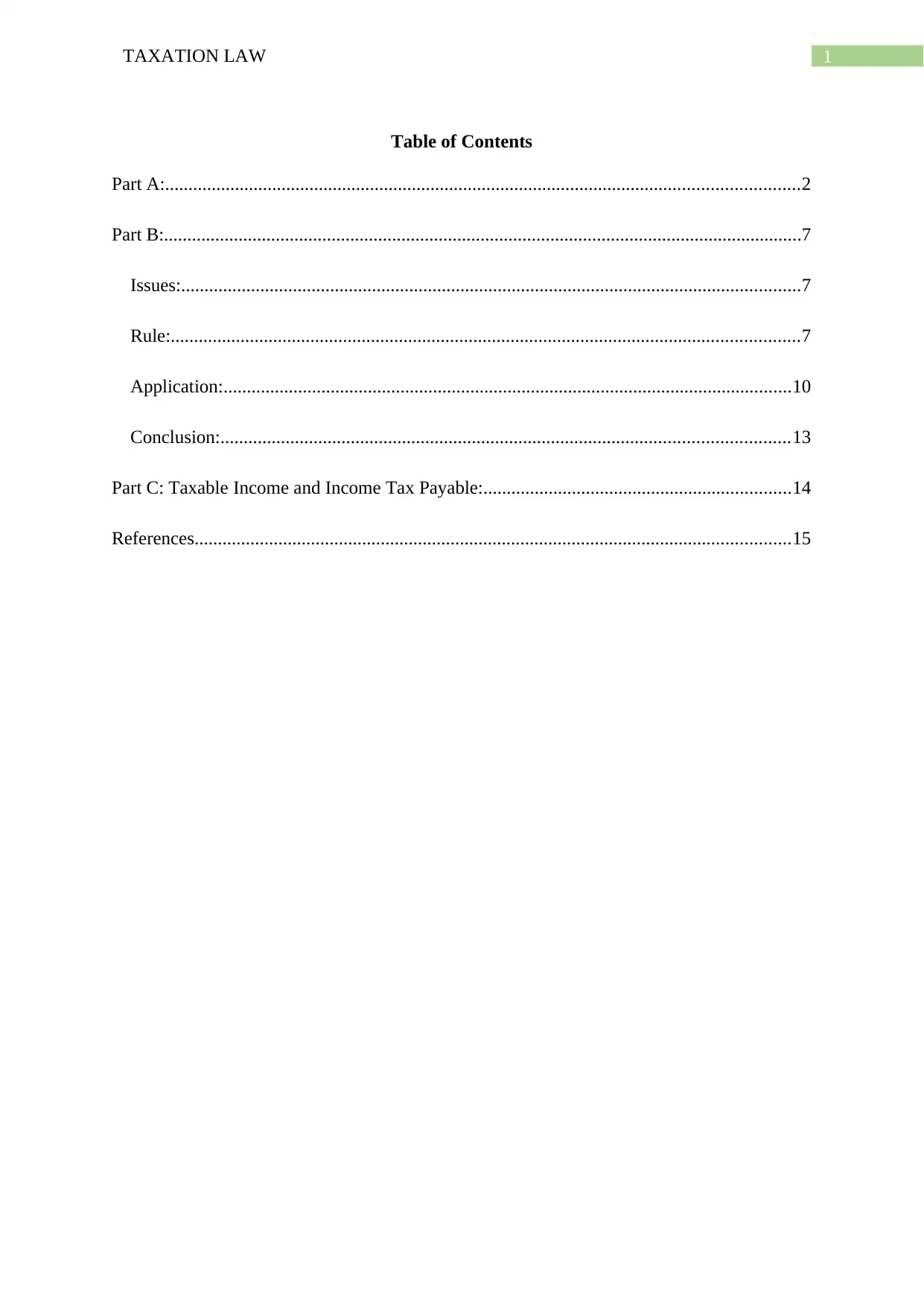
1TAXATION LAW
Table of Contents
Part A:........................................................................................................................................2
Part B:.........................................................................................................................................7
Issues:.....................................................................................................................................7
Rule:.......................................................................................................................................7
Application:..........................................................................................................................10
Conclusion:..........................................................................................................................13
Part C: Taxable Income and Income Tax Payable:..................................................................14
References................................................................................................................................15
Table of Contents
Part A:........................................................................................................................................2
Part B:.........................................................................................................................................7
Issues:.....................................................................................................................................7
Rule:.......................................................................................................................................7
Application:..........................................................................................................................10
Conclusion:..........................................................................................................................13
Part C: Taxable Income and Income Tax Payable:..................................................................14
References................................................................................................................................15

2TAXATION LAW
Part A:
As noted in the “sec 6-5 ITAA 1997”, the assessable earnings of a person includes the
pay in arrangement with the “ordinary concepts” which is recognized as “ordinary income”.
As explained in “sec 6 (1) ITAA 1936”, earnings which is got from the “personal exertion”
involves rewards for services and payments that are considered related to occupation but does
not involves gifts or any other payments for surrendering of rights1. The examples are salary,
wages, bonus, commissions etc. Receipts which is linked to the performance of contracts or
providing of services, it is viewed as the character of payment recipients hands. It must hold
an adequate nexus among the amount and the earnings generating activity. As given in
“Hayes v FCT (1956)” the receipt is usually viewed as the creation or event of service or the
reward for service.
Rick in the present situation reports the receipt of annual salary of $1.2 million from
DxP. Along with his salary he also reports the receiving of performance bonus amounting to
$400,000. With respect to the “sec 6 (1) ITAA 1936” the salary received and performance
bonus should be characterised as personal exertion income. Mentioning “Hayes v FCT
(1956)” the performance bonus and remuneration is the produce or occurrence of service or
the reward for service2. The receipt establishes a nexus with Rick’s employment and amounts
to an “ordinary income” under “sec 6-5 ITAA 1997”.
The sign-on fees are regarded as the receipt of fees as the part of usual practices of
inviting individuals in a novel occupation contract. As held in “Pickford v FCT (1998)” the
law court stated that these types of receipts are viewed as payment for upcoming services and
1 Barkoczy, Stephen, Foundations Of Taxation Law 2014
2 Deutsch, Robert Et Al, Australian Tax Handbook 2018 (Thomson Reuters Australia, 2018)
Part A:
As noted in the “sec 6-5 ITAA 1997”, the assessable earnings of a person includes the
pay in arrangement with the “ordinary concepts” which is recognized as “ordinary income”.
As explained in “sec 6 (1) ITAA 1936”, earnings which is got from the “personal exertion”
involves rewards for services and payments that are considered related to occupation but does
not involves gifts or any other payments for surrendering of rights1. The examples are salary,
wages, bonus, commissions etc. Receipts which is linked to the performance of contracts or
providing of services, it is viewed as the character of payment recipients hands. It must hold
an adequate nexus among the amount and the earnings generating activity. As given in
“Hayes v FCT (1956)” the receipt is usually viewed as the creation or event of service or the
reward for service.
Rick in the present situation reports the receipt of annual salary of $1.2 million from
DxP. Along with his salary he also reports the receiving of performance bonus amounting to
$400,000. With respect to the “sec 6 (1) ITAA 1936” the salary received and performance
bonus should be characterised as personal exertion income. Mentioning “Hayes v FCT
(1956)” the performance bonus and remuneration is the produce or occurrence of service or
the reward for service2. The receipt establishes a nexus with Rick’s employment and amounts
to an “ordinary income” under “sec 6-5 ITAA 1997”.
The sign-on fees are regarded as the receipt of fees as the part of usual practices of
inviting individuals in a novel occupation contract. As held in “Pickford v FCT (1998)” the
law court stated that these types of receipts are viewed as payment for upcoming services and
1 Barkoczy, Stephen, Foundations Of Taxation Law 2014
2 Deutsch, Robert Et Al, Australian Tax Handbook 2018 (Thomson Reuters Australia, 2018)
⊘ This is a preview!⊘
Do you want full access?
Subscribe today to unlock all pages.

Trusted by 1+ million students worldwide
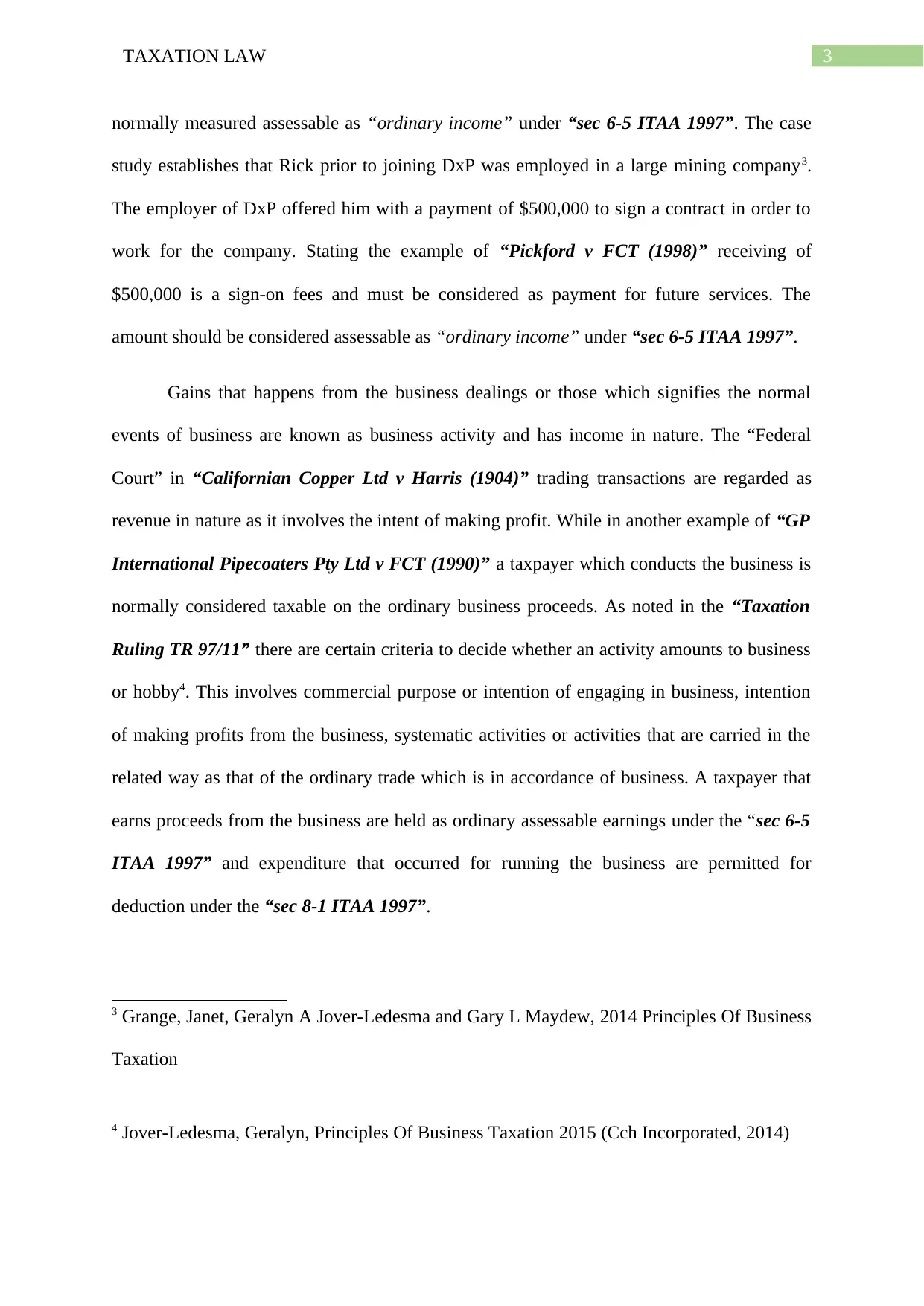
3TAXATION LAW
normally measured assessable as “ordinary income” under “sec 6-5 ITAA 1997”. The case
study establishes that Rick prior to joining DxP was employed in a large mining company3.
The employer of DxP offered him with a payment of $500,000 to sign a contract in order to
work for the company. Stating the example of “Pickford v FCT (1998)” receiving of
$500,000 is a sign-on fees and must be considered as payment for future services. The
amount should be considered assessable as “ordinary income” under “sec 6-5 ITAA 1997”.
Gains that happens from the business dealings or those which signifies the normal
events of business are known as business activity and has income in nature. The “Federal
Court” in “Californian Copper Ltd v Harris (1904)” trading transactions are regarded as
revenue in nature as it involves the intent of making profit. While in another example of “GP
International Pipecoaters Pty Ltd v FCT (1990)” a taxpayer which conducts the business is
normally considered taxable on the ordinary business proceeds. As noted in the “Taxation
Ruling TR 97/11” there are certain criteria to decide whether an activity amounts to business
or hobby4. This involves commercial purpose or intention of engaging in business, intention
of making profits from the business, systematic activities or activities that are carried in the
related way as that of the ordinary trade which is in accordance of business. A taxpayer that
earns proceeds from the business are held as ordinary assessable earnings under the “sec 6-5
ITAA 1997” and expenditure that occurred for running the business are permitted for
deduction under the “sec 8-1 ITAA 1997”.
3 Grange, Janet, Geralyn A Jover-Ledesma and Gary L Maydew, 2014 Principles Of Business
Taxation
4 Jover-Ledesma, Geralyn, Principles Of Business Taxation 2015 (Cch Incorporated, 2014)
normally measured assessable as “ordinary income” under “sec 6-5 ITAA 1997”. The case
study establishes that Rick prior to joining DxP was employed in a large mining company3.
The employer of DxP offered him with a payment of $500,000 to sign a contract in order to
work for the company. Stating the example of “Pickford v FCT (1998)” receiving of
$500,000 is a sign-on fees and must be considered as payment for future services. The
amount should be considered assessable as “ordinary income” under “sec 6-5 ITAA 1997”.
Gains that happens from the business dealings or those which signifies the normal
events of business are known as business activity and has income in nature. The “Federal
Court” in “Californian Copper Ltd v Harris (1904)” trading transactions are regarded as
revenue in nature as it involves the intent of making profit. While in another example of “GP
International Pipecoaters Pty Ltd v FCT (1990)” a taxpayer which conducts the business is
normally considered taxable on the ordinary business proceeds. As noted in the “Taxation
Ruling TR 97/11” there are certain criteria to decide whether an activity amounts to business
or hobby4. This involves commercial purpose or intention of engaging in business, intention
of making profits from the business, systematic activities or activities that are carried in the
related way as that of the ordinary trade which is in accordance of business. A taxpayer that
earns proceeds from the business are held as ordinary assessable earnings under the “sec 6-5
ITAA 1997” and expenditure that occurred for running the business are permitted for
deduction under the “sec 8-1 ITAA 1997”.
3 Grange, Janet, Geralyn A Jover-Ledesma and Gary L Maydew, 2014 Principles Of Business
Taxation
4 Jover-Ledesma, Geralyn, Principles Of Business Taxation 2015 (Cch Incorporated, 2014)
Paraphrase This Document
Need a fresh take? Get an instant paraphrase of this document with our AI Paraphraser

4TAXATION LAW
Accordingly in case of Rick, he made sculptures and occasionally sold in the local
market to simply cover the furniture cost and cost involved in material. However, on one
occasion Rick was contacted by the owner of art gallery to show his sculpture in his art
gallery. The sculpture of Rick’s massively attracted the attention of buyers and all his
sculpture were sold. During the year Rick made an income of $300,000 from the sale of
sculpture. He also developed plans for growing the revenue from his sculpture activity as
well5. With regard to the “section 995-1 ITAA 1997” the activity of selling sculpture by Rick
should be viewed as business activity. Citing “Californian Copper Ltd v Harris (1904)” the
sum of $300,000 from the sale of sculpture must be viewed as gains that represents the
ordinary incidence of business. There was a commercial purpose and also involved the
intention of making profit from the business. Systematic arrangement such as hiring
accountants and employing art students to help him out represented business-like manner6.
Stating to “GP International Pipecoaters Pty Ltd v FCT (1990)” the sum of $300,000 is an
ordinary proceeds of business and will be measured chargeable as “ordinary income” under
“sec 6-5 ITAA 1997”.
During the year Rick reported the receipt of $50,000 as the award from the Australian
Sculpture Institute for being the Best New Artist of the year. As noted in “Moore v Griffiths
(1972)” simple prize winning is not an income but the taxpayer should note that it will be
treated as earnings if there is a satisfactory relation with the taxpayers revenue generating
activates7. The law court in the case of “Kelly v FCT (1985)” held that a qualified footballer
5 Kenny, Paul, Michael Blissenden and Sylvia Villios, Australian Tax 2018
6 NETHERCOTT, LES, Australian Taxation Study Manual (OXFORD University Press,
2018)
7 Sadiq, Kerrie, Australian Taxation Law Cases 2018 (Thomson Reuters, 2018)
Accordingly in case of Rick, he made sculptures and occasionally sold in the local
market to simply cover the furniture cost and cost involved in material. However, on one
occasion Rick was contacted by the owner of art gallery to show his sculpture in his art
gallery. The sculpture of Rick’s massively attracted the attention of buyers and all his
sculpture were sold. During the year Rick made an income of $300,000 from the sale of
sculpture. He also developed plans for growing the revenue from his sculpture activity as
well5. With regard to the “section 995-1 ITAA 1997” the activity of selling sculpture by Rick
should be viewed as business activity. Citing “Californian Copper Ltd v Harris (1904)” the
sum of $300,000 from the sale of sculpture must be viewed as gains that represents the
ordinary incidence of business. There was a commercial purpose and also involved the
intention of making profit from the business. Systematic arrangement such as hiring
accountants and employing art students to help him out represented business-like manner6.
Stating to “GP International Pipecoaters Pty Ltd v FCT (1990)” the sum of $300,000 is an
ordinary proceeds of business and will be measured chargeable as “ordinary income” under
“sec 6-5 ITAA 1997”.
During the year Rick reported the receipt of $50,000 as the award from the Australian
Sculpture Institute for being the Best New Artist of the year. As noted in “Moore v Griffiths
(1972)” simple prize winning is not an income but the taxpayer should note that it will be
treated as earnings if there is a satisfactory relation with the taxpayers revenue generating
activates7. The law court in the case of “Kelly v FCT (1985)” held that a qualified footballer
5 Kenny, Paul, Michael Blissenden and Sylvia Villios, Australian Tax 2018
6 NETHERCOTT, LES, Australian Taxation Study Manual (OXFORD University Press,
2018)
7 Sadiq, Kerrie, Australian Taxation Law Cases 2018 (Thomson Reuters, 2018)
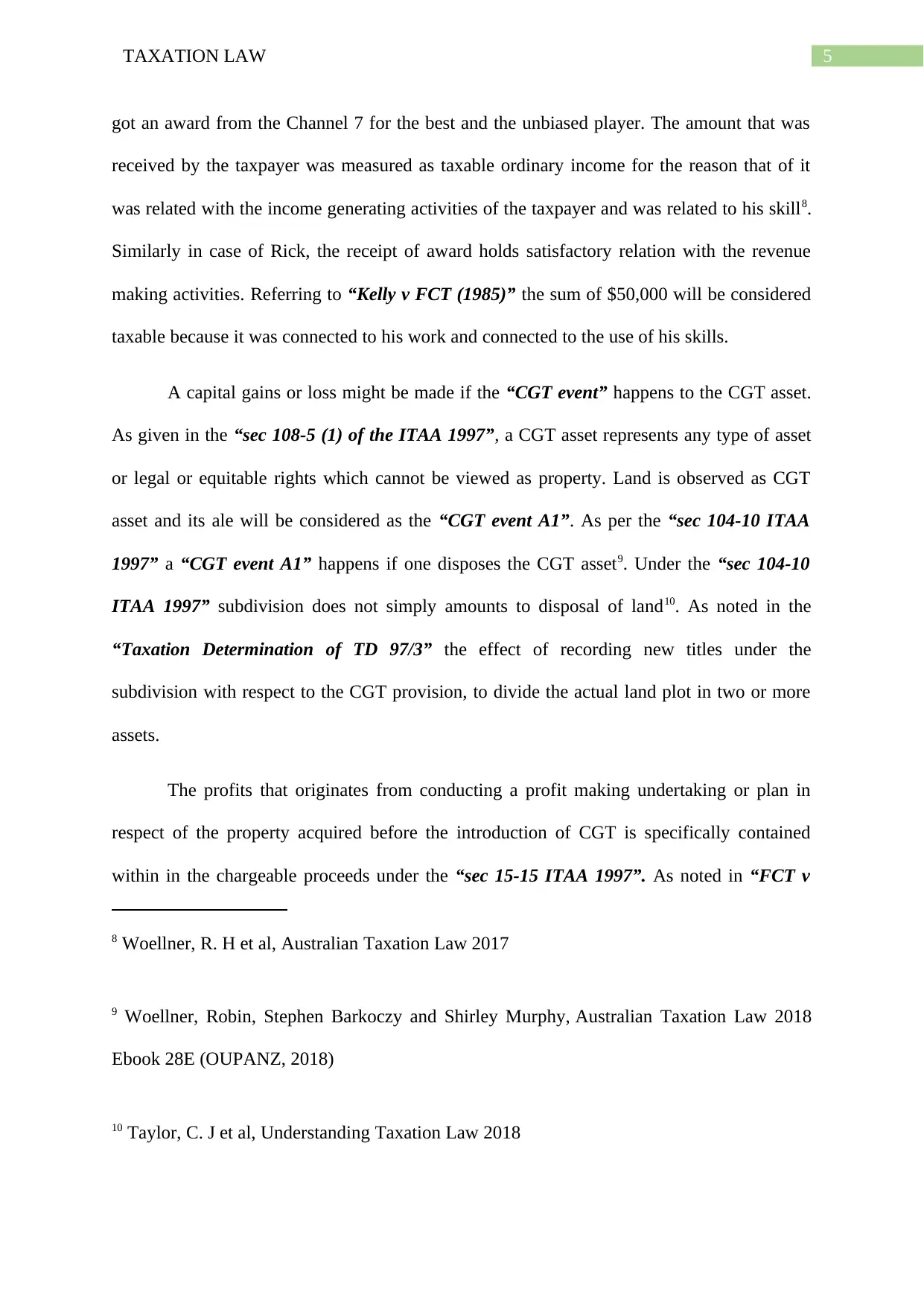
5TAXATION LAW
got an award from the Channel 7 for the best and the unbiased player. The amount that was
received by the taxpayer was measured as taxable ordinary income for the reason that of it
was related with the income generating activities of the taxpayer and was related to his skill8.
Similarly in case of Rick, the receipt of award holds satisfactory relation with the revenue
making activities. Referring to “Kelly v FCT (1985)” the sum of $50,000 will be considered
taxable because it was connected to his work and connected to the use of his skills.
A capital gains or loss might be made if the “CGT event” happens to the CGT asset.
As given in the “sec 108-5 (1) of the ITAA 1997”, a CGT asset represents any type of asset
or legal or equitable rights which cannot be viewed as property. Land is observed as CGT
asset and its ale will be considered as the “CGT event A1”. As per the “sec 104-10 ITAA
1997” a “CGT event A1” happens if one disposes the CGT asset9. Under the “sec 104-10
ITAA 1997” subdivision does not simply amounts to disposal of land10. As noted in the
“Taxation Determination of TD 97/3” the effect of recording new titles under the
subdivision with respect to the CGT provision, to divide the actual land plot in two or more
assets.
The profits that originates from conducting a profit making undertaking or plan in
respect of the property acquired before the introduction of CGT is specifically contained
within in the chargeable proceeds under the “sec 15-15 ITAA 1997”. As noted in “FCT v
8 Woellner, R. H et al, Australian Taxation Law 2017
9 Woellner, Robin, Stephen Barkoczy and Shirley Murphy, Australian Taxation Law 2018
Ebook 28E (OUPANZ, 2018)
10 Taylor, C. J et al, Understanding Taxation Law 2018
got an award from the Channel 7 for the best and the unbiased player. The amount that was
received by the taxpayer was measured as taxable ordinary income for the reason that of it
was related with the income generating activities of the taxpayer and was related to his skill8.
Similarly in case of Rick, the receipt of award holds satisfactory relation with the revenue
making activities. Referring to “Kelly v FCT (1985)” the sum of $50,000 will be considered
taxable because it was connected to his work and connected to the use of his skills.
A capital gains or loss might be made if the “CGT event” happens to the CGT asset.
As given in the “sec 108-5 (1) of the ITAA 1997”, a CGT asset represents any type of asset
or legal or equitable rights which cannot be viewed as property. Land is observed as CGT
asset and its ale will be considered as the “CGT event A1”. As per the “sec 104-10 ITAA
1997” a “CGT event A1” happens if one disposes the CGT asset9. Under the “sec 104-10
ITAA 1997” subdivision does not simply amounts to disposal of land10. As noted in the
“Taxation Determination of TD 97/3” the effect of recording new titles under the
subdivision with respect to the CGT provision, to divide the actual land plot in two or more
assets.
The profits that originates from conducting a profit making undertaking or plan in
respect of the property acquired before the introduction of CGT is specifically contained
within in the chargeable proceeds under the “sec 15-15 ITAA 1997”. As noted in “FCT v
8 Woellner, R. H et al, Australian Taxation Law 2017
9 Woellner, Robin, Stephen Barkoczy and Shirley Murphy, Australian Taxation Law 2018
Ebook 28E (OUPANZ, 2018)
10 Taylor, C. J et al, Understanding Taxation Law 2018
⊘ This is a preview!⊘
Do you want full access?
Subscribe today to unlock all pages.

Trusted by 1+ million students worldwide
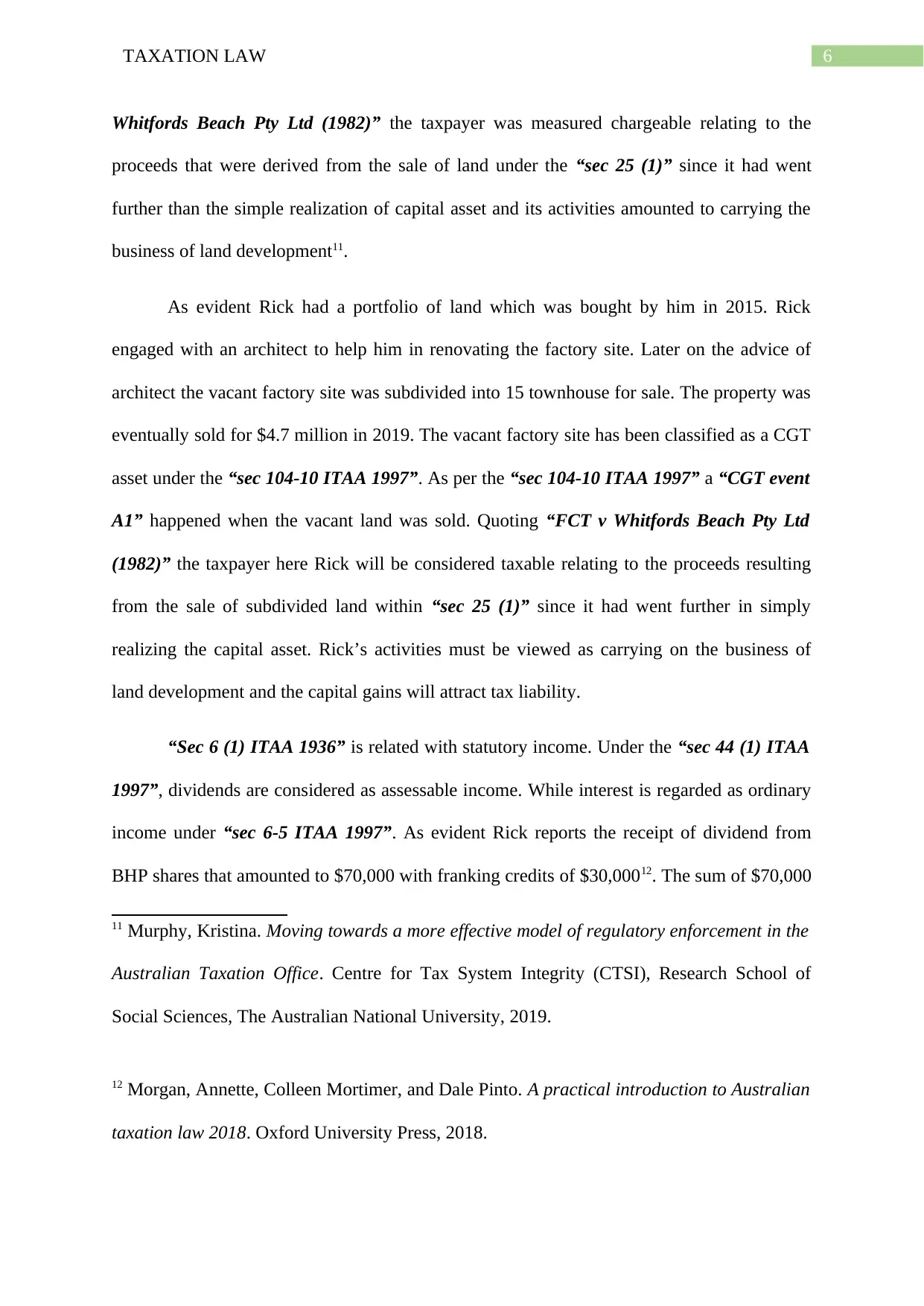
6TAXATION LAW
Whitfords Beach Pty Ltd (1982)” the taxpayer was measured chargeable relating to the
proceeds that were derived from the sale of land under the “sec 25 (1)” since it had went
further than the simple realization of capital asset and its activities amounted to carrying the
business of land development11.
As evident Rick had a portfolio of land which was bought by him in 2015. Rick
engaged with an architect to help him in renovating the factory site. Later on the advice of
architect the vacant factory site was subdivided into 15 townhouse for sale. The property was
eventually sold for $4.7 million in 2019. The vacant factory site has been classified as a CGT
asset under the “sec 104-10 ITAA 1997”. As per the “sec 104-10 ITAA 1997” a “CGT event
A1” happened when the vacant land was sold. Quoting “FCT v Whitfords Beach Pty Ltd
(1982)” the taxpayer here Rick will be considered taxable relating to the proceeds resulting
from the sale of subdivided land within “sec 25 (1)” since it had went further in simply
realizing the capital asset. Rick’s activities must be viewed as carrying on the business of
land development and the capital gains will attract tax liability.
“Sec 6 (1) ITAA 1936” is related with statutory income. Under the “sec 44 (1) ITAA
1997”, dividends are considered as assessable income. While interest is regarded as ordinary
income under “sec 6-5 ITAA 1997”. As evident Rick reports the receipt of dividend from
BHP shares that amounted to $70,000 with franking credits of $30,00012. The sum of $70,000
11 Murphy, Kristina. Moving towards a more effective model of regulatory enforcement in the
Australian Taxation Office. Centre for Tax System Integrity (CTSI), Research School of
Social Sciences, The Australian National University, 2019.
12 Morgan, Annette, Colleen Mortimer, and Dale Pinto. A practical introduction to Australian
taxation law 2018. Oxford University Press, 2018.
Whitfords Beach Pty Ltd (1982)” the taxpayer was measured chargeable relating to the
proceeds that were derived from the sale of land under the “sec 25 (1)” since it had went
further than the simple realization of capital asset and its activities amounted to carrying the
business of land development11.
As evident Rick had a portfolio of land which was bought by him in 2015. Rick
engaged with an architect to help him in renovating the factory site. Later on the advice of
architect the vacant factory site was subdivided into 15 townhouse for sale. The property was
eventually sold for $4.7 million in 2019. The vacant factory site has been classified as a CGT
asset under the “sec 104-10 ITAA 1997”. As per the “sec 104-10 ITAA 1997” a “CGT event
A1” happened when the vacant land was sold. Quoting “FCT v Whitfords Beach Pty Ltd
(1982)” the taxpayer here Rick will be considered taxable relating to the proceeds resulting
from the sale of subdivided land within “sec 25 (1)” since it had went further in simply
realizing the capital asset. Rick’s activities must be viewed as carrying on the business of
land development and the capital gains will attract tax liability.
“Sec 6 (1) ITAA 1936” is related with statutory income. Under the “sec 44 (1) ITAA
1997”, dividends are considered as assessable income. While interest is regarded as ordinary
income under “sec 6-5 ITAA 1997”. As evident Rick reports the receipt of dividend from
BHP shares that amounted to $70,000 with franking credits of $30,00012. The sum of $70,000
11 Murphy, Kristina. Moving towards a more effective model of regulatory enforcement in the
Australian Taxation Office. Centre for Tax System Integrity (CTSI), Research School of
Social Sciences, The Australian National University, 2019.
12 Morgan, Annette, Colleen Mortimer, and Dale Pinto. A practical introduction to Australian
taxation law 2018. Oxford University Press, 2018.
Paraphrase This Document
Need a fresh take? Get an instant paraphrase of this document with our AI Paraphraser

7TAXATION LAW
received as dividend will be considered chargeable as “statutory income” under “sec 44 (1)
ITAA 1997” while the franking credits will be considered as eligible tax offset. While the
interest of $15,000 will be taxable as “ordinary income” under “sec 6-5 ITAA 1997”.
Part B:
Issues:
Is the taxpayer permitted to obtain an allowable deduction relating to the expenses
occurred in the derivation of income under “sec 8-1 ITAA 1997”?
Rule:
Conferring to the “sec 8-1 ITAA 1997”, a person is permitted to get the tax deduction
from the chargeable earnings regarding any sort of loss or expenditure up to the amount that
the incidentals has been incurred in generating the chargeable income13. A taxpayer is
permitted to get deduction when the expenditures are happened necessarily in executing the
business with the purpose of making taxable income. While in the “negative limbs” of
“section 8-1 (2) ITAA 1997” a person is not allowable to get deduction for expenditures or
losses that are private, domestic or capital in type.
In the meantime, expenses which is associated to purchase of trading is allowed for
income tax deduction under “sec 8-1 ITAA 1997”. While as per “sec 26-5 ITAA 1997” an
individual tax payer is not allowed to get deduction relating to amount which is paid for
penalty for breaching Australian law or foreign law or any type of amount which is ordered
by the court of law to be paid for misdemeanour against Australian law14.
13 Robin & Barkoczy Woellner (Stephen & Murphy, Shirley Et Al.). Australian Taxation
Law 2020. OXFORD University Press, 2020.
14 Taylor, John, et al. Understanding Taxation Law 2018. LexisNexis Butterworths, 2017.
received as dividend will be considered chargeable as “statutory income” under “sec 44 (1)
ITAA 1997” while the franking credits will be considered as eligible tax offset. While the
interest of $15,000 will be taxable as “ordinary income” under “sec 6-5 ITAA 1997”.
Part B:
Issues:
Is the taxpayer permitted to obtain an allowable deduction relating to the expenses
occurred in the derivation of income under “sec 8-1 ITAA 1997”?
Rule:
Conferring to the “sec 8-1 ITAA 1997”, a person is permitted to get the tax deduction
from the chargeable earnings regarding any sort of loss or expenditure up to the amount that
the incidentals has been incurred in generating the chargeable income13. A taxpayer is
permitted to get deduction when the expenditures are happened necessarily in executing the
business with the purpose of making taxable income. While in the “negative limbs” of
“section 8-1 (2) ITAA 1997” a person is not allowable to get deduction for expenditures or
losses that are private, domestic or capital in type.
In the meantime, expenses which is associated to purchase of trading is allowed for
income tax deduction under “sec 8-1 ITAA 1997”. While as per “sec 26-5 ITAA 1997” an
individual tax payer is not allowed to get deduction relating to amount which is paid for
penalty for breaching Australian law or foreign law or any type of amount which is ordered
by the court of law to be paid for misdemeanour against Australian law14.
13 Robin & Barkoczy Woellner (Stephen & Murphy, Shirley Et Al.). Australian Taxation
Law 2020. OXFORD University Press, 2020.
14 Taylor, John, et al. Understanding Taxation Law 2018. LexisNexis Butterworths, 2017.
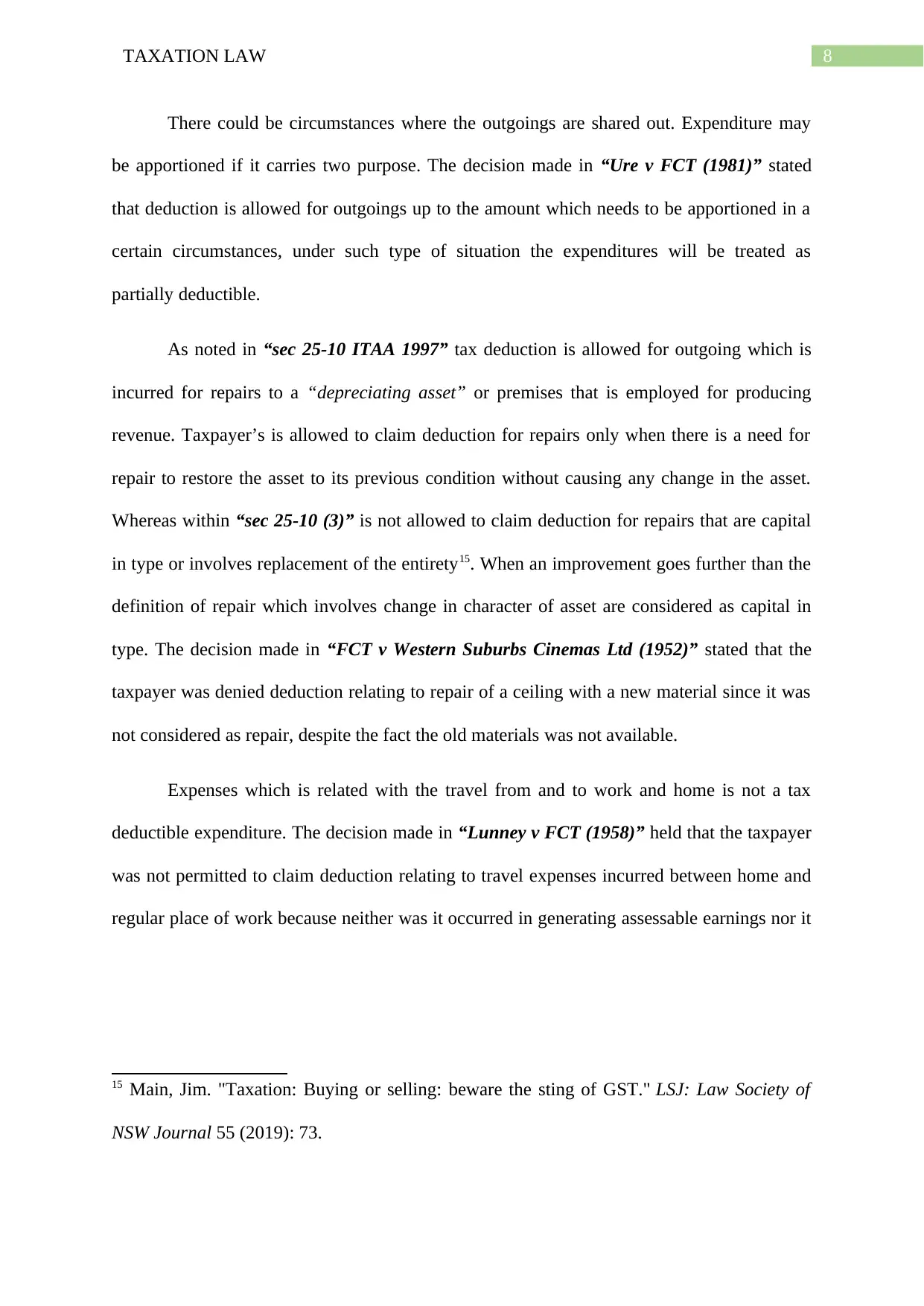
8TAXATION LAW
There could be circumstances where the outgoings are shared out. Expenditure may
be apportioned if it carries two purpose. The decision made in “Ure v FCT (1981)” stated
that deduction is allowed for outgoings up to the amount which needs to be apportioned in a
certain circumstances, under such type of situation the expenditures will be treated as
partially deductible.
As noted in “sec 25-10 ITAA 1997” tax deduction is allowed for outgoing which is
incurred for repairs to a “depreciating asset” or premises that is employed for producing
revenue. Taxpayer’s is allowed to claim deduction for repairs only when there is a need for
repair to restore the asset to its previous condition without causing any change in the asset.
Whereas within “sec 25-10 (3)” is not allowed to claim deduction for repairs that are capital
in type or involves replacement of the entirety15. When an improvement goes further than the
definition of repair which involves change in character of asset are considered as capital in
type. The decision made in “FCT v Western Suburbs Cinemas Ltd (1952)” stated that the
taxpayer was denied deduction relating to repair of a ceiling with a new material since it was
not considered as repair, despite the fact the old materials was not available.
Expenses which is related with the travel from and to work and home is not a tax
deductible expenditure. The decision made in “Lunney v FCT (1958)” held that the taxpayer
was not permitted to claim deduction relating to travel expenses incurred between home and
regular place of work because neither was it occurred in generating assessable earnings nor it
15 Main, Jim. "Taxation: Buying or selling: beware the sting of GST." LSJ: Law Society of
NSW Journal 55 (2019): 73.
There could be circumstances where the outgoings are shared out. Expenditure may
be apportioned if it carries two purpose. The decision made in “Ure v FCT (1981)” stated
that deduction is allowed for outgoings up to the amount which needs to be apportioned in a
certain circumstances, under such type of situation the expenditures will be treated as
partially deductible.
As noted in “sec 25-10 ITAA 1997” tax deduction is allowed for outgoing which is
incurred for repairs to a “depreciating asset” or premises that is employed for producing
revenue. Taxpayer’s is allowed to claim deduction for repairs only when there is a need for
repair to restore the asset to its previous condition without causing any change in the asset.
Whereas within “sec 25-10 (3)” is not allowed to claim deduction for repairs that are capital
in type or involves replacement of the entirety15. When an improvement goes further than the
definition of repair which involves change in character of asset are considered as capital in
type. The decision made in “FCT v Western Suburbs Cinemas Ltd (1952)” stated that the
taxpayer was denied deduction relating to repair of a ceiling with a new material since it was
not considered as repair, despite the fact the old materials was not available.
Expenses which is related with the travel from and to work and home is not a tax
deductible expenditure. The decision made in “Lunney v FCT (1958)” held that the taxpayer
was not permitted to claim deduction relating to travel expenses incurred between home and
regular place of work because neither was it occurred in generating assessable earnings nor it
15 Main, Jim. "Taxation: Buying or selling: beware the sting of GST." LSJ: Law Society of
NSW Journal 55 (2019): 73.
⊘ This is a preview!⊘
Do you want full access?
Subscribe today to unlock all pages.

Trusted by 1+ million students worldwide
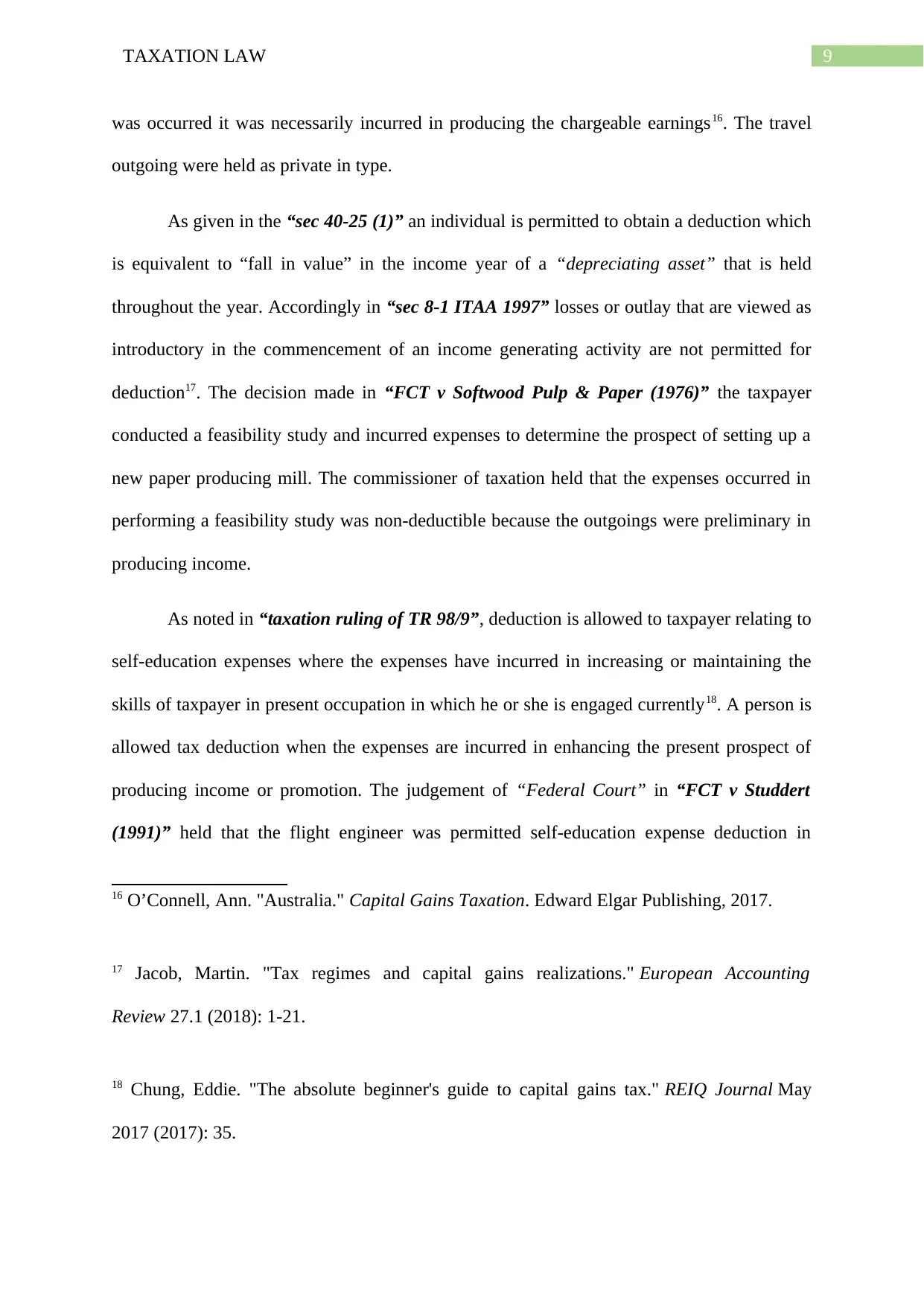
9TAXATION LAW
was occurred it was necessarily incurred in producing the chargeable earnings16. The travel
outgoing were held as private in type.
As given in the “sec 40-25 (1)” an individual is permitted to obtain a deduction which
is equivalent to “fall in value” in the income year of a “depreciating asset” that is held
throughout the year. Accordingly in “sec 8-1 ITAA 1997” losses or outlay that are viewed as
introductory in the commencement of an income generating activity are not permitted for
deduction17. The decision made in “FCT v Softwood Pulp & Paper (1976)” the taxpayer
conducted a feasibility study and incurred expenses to determine the prospect of setting up a
new paper producing mill. The commissioner of taxation held that the expenses occurred in
performing a feasibility study was non-deductible because the outgoings were preliminary in
producing income.
As noted in “taxation ruling of TR 98/9”, deduction is allowed to taxpayer relating to
self-education expenses where the expenses have incurred in increasing or maintaining the
skills of taxpayer in present occupation in which he or she is engaged currently18. A person is
allowed tax deduction when the expenses are incurred in enhancing the present prospect of
producing income or promotion. The judgement of “Federal Court” in “FCT v Studdert
(1991)” held that the flight engineer was permitted self-education expense deduction in
16 O’Connell, Ann. "Australia." Capital Gains Taxation. Edward Elgar Publishing, 2017.
17 Jacob, Martin. "Tax regimes and capital gains realizations." European Accounting
Review 27.1 (2018): 1-21.
18 Chung, Eddie. "The absolute beginner's guide to capital gains tax." REIQ Journal May
2017 (2017): 35.
was occurred it was necessarily incurred in producing the chargeable earnings16. The travel
outgoing were held as private in type.
As given in the “sec 40-25 (1)” an individual is permitted to obtain a deduction which
is equivalent to “fall in value” in the income year of a “depreciating asset” that is held
throughout the year. Accordingly in “sec 8-1 ITAA 1997” losses or outlay that are viewed as
introductory in the commencement of an income generating activity are not permitted for
deduction17. The decision made in “FCT v Softwood Pulp & Paper (1976)” the taxpayer
conducted a feasibility study and incurred expenses to determine the prospect of setting up a
new paper producing mill. The commissioner of taxation held that the expenses occurred in
performing a feasibility study was non-deductible because the outgoings were preliminary in
producing income.
As noted in “taxation ruling of TR 98/9”, deduction is allowed to taxpayer relating to
self-education expenses where the expenses have incurred in increasing or maintaining the
skills of taxpayer in present occupation in which he or she is engaged currently18. A person is
allowed tax deduction when the expenses are incurred in enhancing the present prospect of
producing income or promotion. The judgement of “Federal Court” in “FCT v Studdert
(1991)” held that the flight engineer was permitted self-education expense deduction in
16 O’Connell, Ann. "Australia." Capital Gains Taxation. Edward Elgar Publishing, 2017.
17 Jacob, Martin. "Tax regimes and capital gains realizations." European Accounting
Review 27.1 (2018): 1-21.
18 Chung, Eddie. "The absolute beginner's guide to capital gains tax." REIQ Journal May
2017 (2017): 35.
Paraphrase This Document
Need a fresh take? Get an instant paraphrase of this document with our AI Paraphraser
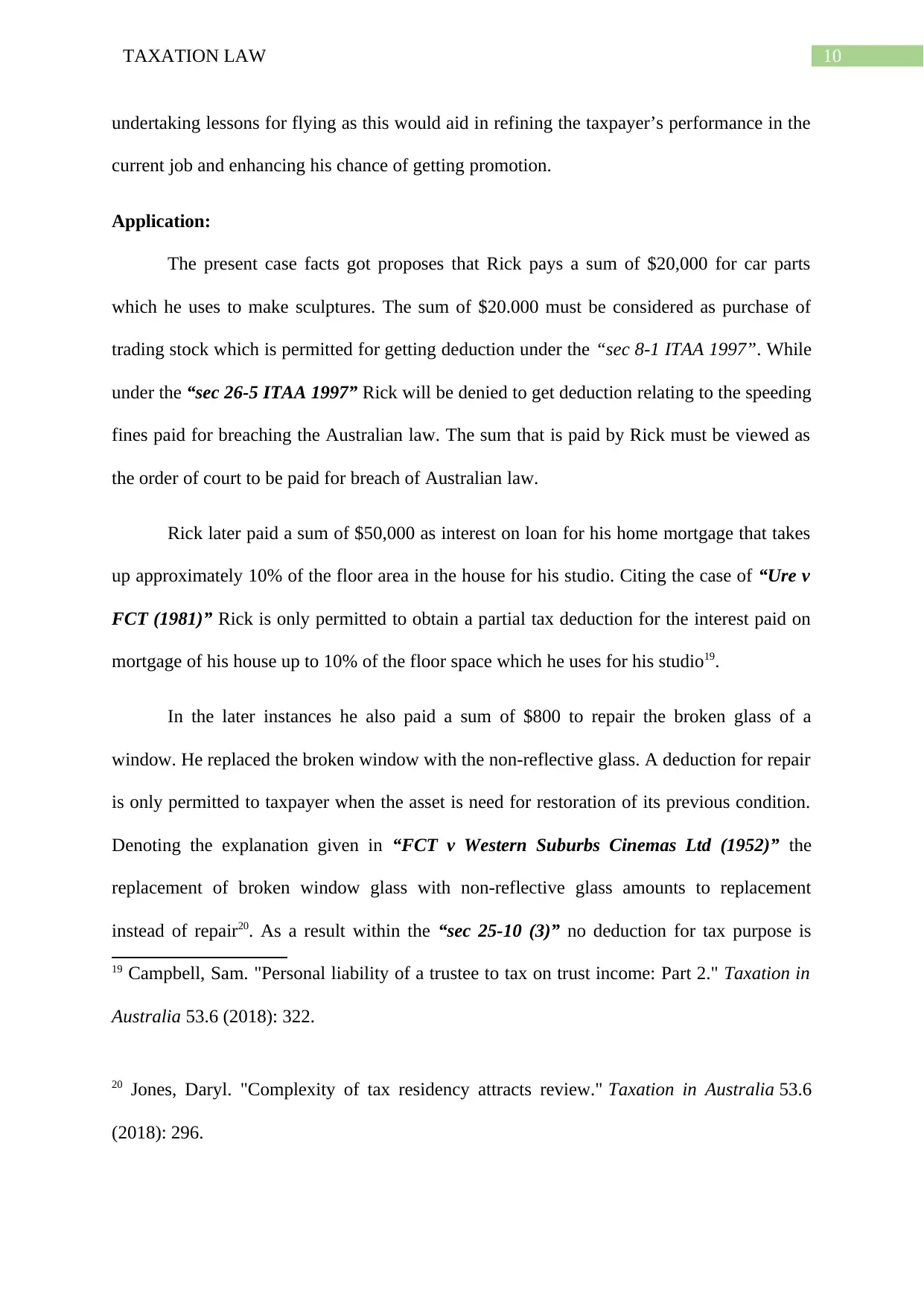
10TAXATION LAW
undertaking lessons for flying as this would aid in refining the taxpayer’s performance in the
current job and enhancing his chance of getting promotion.
Application:
The present case facts got proposes that Rick pays a sum of $20,000 for car parts
which he uses to make sculptures. The sum of $20.000 must be considered as purchase of
trading stock which is permitted for getting deduction under the “sec 8-1 ITAA 1997”. While
under the “sec 26-5 ITAA 1997” Rick will be denied to get deduction relating to the speeding
fines paid for breaching the Australian law. The sum that is paid by Rick must be viewed as
the order of court to be paid for breach of Australian law.
Rick later paid a sum of $50,000 as interest on loan for his home mortgage that takes
up approximately 10% of the floor area in the house for his studio. Citing the case of “Ure v
FCT (1981)” Rick is only permitted to obtain a partial tax deduction for the interest paid on
mortgage of his house up to 10% of the floor space which he uses for his studio19.
In the later instances he also paid a sum of $800 to repair the broken glass of a
window. He replaced the broken window with the non-reflective glass. A deduction for repair
is only permitted to taxpayer when the asset is need for restoration of its previous condition.
Denoting the explanation given in “FCT v Western Suburbs Cinemas Ltd (1952)” the
replacement of broken window glass with non-reflective glass amounts to replacement
instead of repair20. As a result within the “sec 25-10 (3)” no deduction for tax purpose is
19 Campbell, Sam. "Personal liability of a trustee to tax on trust income: Part 2." Taxation in
Australia 53.6 (2018): 322.
20 Jones, Daryl. "Complexity of tax residency attracts review." Taxation in Australia 53.6
(2018): 296.
undertaking lessons for flying as this would aid in refining the taxpayer’s performance in the
current job and enhancing his chance of getting promotion.
Application:
The present case facts got proposes that Rick pays a sum of $20,000 for car parts
which he uses to make sculptures. The sum of $20.000 must be considered as purchase of
trading stock which is permitted for getting deduction under the “sec 8-1 ITAA 1997”. While
under the “sec 26-5 ITAA 1997” Rick will be denied to get deduction relating to the speeding
fines paid for breaching the Australian law. The sum that is paid by Rick must be viewed as
the order of court to be paid for breach of Australian law.
Rick later paid a sum of $50,000 as interest on loan for his home mortgage that takes
up approximately 10% of the floor area in the house for his studio. Citing the case of “Ure v
FCT (1981)” Rick is only permitted to obtain a partial tax deduction for the interest paid on
mortgage of his house up to 10% of the floor space which he uses for his studio19.
In the later instances he also paid a sum of $800 to repair the broken glass of a
window. He replaced the broken window with the non-reflective glass. A deduction for repair
is only permitted to taxpayer when the asset is need for restoration of its previous condition.
Denoting the explanation given in “FCT v Western Suburbs Cinemas Ltd (1952)” the
replacement of broken window glass with non-reflective glass amounts to replacement
instead of repair20. As a result within the “sec 25-10 (3)” no deduction for tax purpose is
19 Campbell, Sam. "Personal liability of a trustee to tax on trust income: Part 2." Taxation in
Australia 53.6 (2018): 322.
20 Jones, Daryl. "Complexity of tax residency attracts review." Taxation in Australia 53.6
(2018): 296.

11TAXATION LAW
permitted to Rick since the outgoings are capital in type and comprises of replacement of
entirety.
In the later part Rick reports outgoing for travel purpose between his home and office.
Reference to the case of “Lunney v FCT (1958)” can be referred to clarify that the travel
outgoing occurred is a private arrangement21. Therefore, under the “sec 8-1 ITAA 1997” Rick
is not permitted to get deduction for the expenses since it is neither incidental to his income
making activities nor it is relevant in producing chargeable earnings.
Rick bought a welding machine costing $20,000 of industrial quality that he uses for
his work purpose having a life span of 20 years. Denoting the explanation given in “sec 40-
25 (1)” it can be stated that Rick can claim a tax deduction which is equal to the sum of
“decline in value” during the income year for the wielding machine that is held through the
year22. Rick is recommended to use the prime cost method for depreciating the welding
machine as this will maximize his tax deduction.
Rick conducts an investigation to ascertain the feasibility of commencing a new
business of purchasing and selling the old car which costs him $4,000. The feasibility
expenses that is incurred by Rick is preliminary in type and before the commencement of any
income generating activity. Citing the decision made in “FCT v Softwood Pulp & Paper
(1976)” the feasibility expenditure that is occurred by Rick is not allowable for tax deduction
21 Hanna, Norman. "Applying Sub38div 207-B and Div 6 to franked distributions." Taxation
in Australia 54.3 (2019): 138.
22 White, Judy, and Adele Townsend. "Deductibility of employee travel expenses: The ATO's
guidance." Taxation in Australia 52.11 (2018): 608.
permitted to Rick since the outgoings are capital in type and comprises of replacement of
entirety.
In the later part Rick reports outgoing for travel purpose between his home and office.
Reference to the case of “Lunney v FCT (1958)” can be referred to clarify that the travel
outgoing occurred is a private arrangement21. Therefore, under the “sec 8-1 ITAA 1997” Rick
is not permitted to get deduction for the expenses since it is neither incidental to his income
making activities nor it is relevant in producing chargeable earnings.
Rick bought a welding machine costing $20,000 of industrial quality that he uses for
his work purpose having a life span of 20 years. Denoting the explanation given in “sec 40-
25 (1)” it can be stated that Rick can claim a tax deduction which is equal to the sum of
“decline in value” during the income year for the wielding machine that is held through the
year22. Rick is recommended to use the prime cost method for depreciating the welding
machine as this will maximize his tax deduction.
Rick conducts an investigation to ascertain the feasibility of commencing a new
business of purchasing and selling the old car which costs him $4,000. The feasibility
expenses that is incurred by Rick is preliminary in type and before the commencement of any
income generating activity. Citing the decision made in “FCT v Softwood Pulp & Paper
(1976)” the feasibility expenditure that is occurred by Rick is not allowable for tax deduction
21 Hanna, Norman. "Applying Sub38div 207-B and Div 6 to franked distributions." Taxation
in Australia 54.3 (2019): 138.
22 White, Judy, and Adele Townsend. "Deductibility of employee travel expenses: The ATO's
guidance." Taxation in Australia 52.11 (2018): 608.
⊘ This is a preview!⊘
Do you want full access?
Subscribe today to unlock all pages.

Trusted by 1+ million students worldwide
1 out of 17
Related Documents
Your All-in-One AI-Powered Toolkit for Academic Success.
+13062052269
info@desklib.com
Available 24*7 on WhatsApp / Email
![[object Object]](/_next/static/media/star-bottom.7253800d.svg)
Unlock your academic potential
Copyright © 2020–2025 A2Z Services. All Rights Reserved. Developed and managed by ZUCOL.





